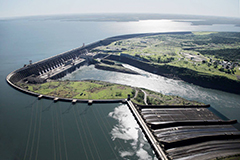Itaipu Dam
The Itaipu Dam is a hydroelectric dam on the Paraná River located on the border between Brazil and Paraguay. The construction of the dam was first contested by Argentina, but the negotiations and resolution of the dispute ended up setting the basis for Argentine–Brazilian integration later on.
 The name "Itaipu" was taken from an isle that existed near the construction site. In the Guarani language, Itaipu means "the sounding stone". The Itaipu Dam's hydroelectric power plant produced the most energy of any in the world as of 2016, setting a new world record of 103,098,366 megawatt hours (MWh), and surpassed the Three Gorges Dam plant in energy production in 2015 and 2016. Completed in 1984, it is a binational undertaking run by Brazil and Paraguay at the border between the two countries, 15 km (9.3 mi) north of the Friendship Bridge. The project ranges from Foz do Iguaçu, in Brazil, and Ciudad del Este in Paraguay, in the south to Guaíra and Salto del Guairá in the north. The installed generation capacity of the plant is 14 GW, with 20 generating units providing 700 MW each with a hydraulic design head of 118 metres (387 ft). In 2016, the plant employed 3038 workers.
The name "Itaipu" was taken from an isle that existed near the construction site. In the Guarani language, Itaipu means "the sounding stone". The Itaipu Dam's hydroelectric power plant produced the most energy of any in the world as of 2016, setting a new world record of 103,098,366 megawatt hours (MWh), and surpassed the Three Gorges Dam plant in energy production in 2015 and 2016. Completed in 1984, it is a binational undertaking run by Brazil and Paraguay at the border between the two countries, 15 km (9.3 mi) north of the Friendship Bridge. The project ranges from Foz do Iguaçu, in Brazil, and Ciudad del Este in Paraguay, in the south to Guaíra and Salto del Guairá in the north. The installed generation capacity of the plant is 14 GW, with 20 generating units providing 700 MW each with a hydraulic design head of 118 metres (387 ft). In 2016, the plant employed 3038 workers.
Of the twenty generator units currently installed, ten generate at 50 Hz for Paraguay and ten generate at 60 Hz for Brazil. Since the output capacity of the Paraguayan generators far exceeds the load in Paraguay, most of their production is exported directly to the Brazilian side, from where two 600 kV HVDC lines, each approximately 800 kilometres (500 mi) long, carry the majority of the energy to the São Paulo/Rio de Janeiro region where the terminal equipment converts the power to 60 Hz. More details
 The name "Itaipu" was taken from an isle that existed near the construction site. In the Guarani language, Itaipu means "the sounding stone". The Itaipu Dam's hydroelectric power plant produced the most energy of any in the world as of 2016, setting a new world record of 103,098,366 megawatt hours (MWh), and surpassed the Three Gorges Dam plant in energy production in 2015 and 2016. Completed in 1984, it is a binational undertaking run by Brazil and Paraguay at the border between the two countries, 15 km (9.3 mi) north of the Friendship Bridge. The project ranges from Foz do Iguaçu, in Brazil, and Ciudad del Este in Paraguay, in the south to Guaíra and Salto del Guairá in the north. The installed generation capacity of the plant is 14 GW, with 20 generating units providing 700 MW each with a hydraulic design head of 118 metres (387 ft). In 2016, the plant employed 3038 workers.
The name "Itaipu" was taken from an isle that existed near the construction site. In the Guarani language, Itaipu means "the sounding stone". The Itaipu Dam's hydroelectric power plant produced the most energy of any in the world as of 2016, setting a new world record of 103,098,366 megawatt hours (MWh), and surpassed the Three Gorges Dam plant in energy production in 2015 and 2016. Completed in 1984, it is a binational undertaking run by Brazil and Paraguay at the border between the two countries, 15 km (9.3 mi) north of the Friendship Bridge. The project ranges from Foz do Iguaçu, in Brazil, and Ciudad del Este in Paraguay, in the south to Guaíra and Salto del Guairá in the north. The installed generation capacity of the plant is 14 GW, with 20 generating units providing 700 MW each with a hydraulic design head of 118 metres (387 ft). In 2016, the plant employed 3038 workers.Of the twenty generator units currently installed, ten generate at 50 Hz for Paraguay and ten generate at 60 Hz for Brazil. Since the output capacity of the Paraguayan generators far exceeds the load in Paraguay, most of their production is exported directly to the Brazilian side, from where two 600 kV HVDC lines, each approximately 800 kilometres (500 mi) long, carry the majority of the energy to the São Paulo/Rio de Janeiro region where the terminal equipment converts the power to 60 Hz. More details
